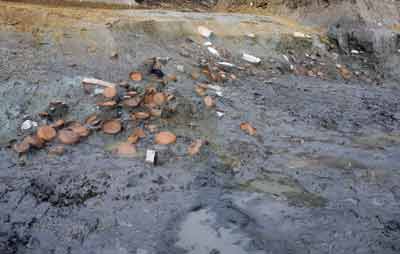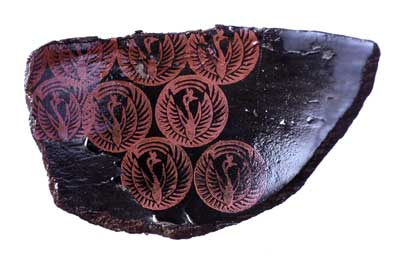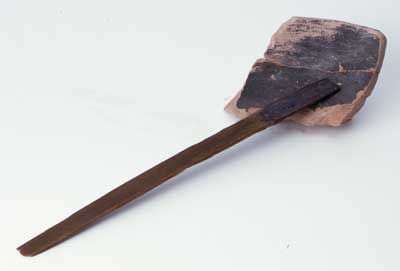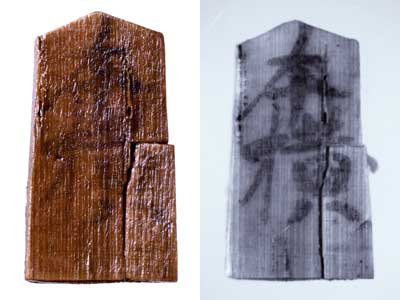Kawanishi:
Large-scale Medieval piled-stone shore edging. Vast amounts of wooden implements and pottery are recovered.
 Panorama of the site (from the east) This is a piled-stone shore edging, 45 m east-west by 10 m north-south in scale. Multiple pilings of stone dating from the Kamakura to the Muromachi periods are visible in the photo. A jetty 15 m or longer, set perpendicular to the shore edging, was built in the Muromachi period.
Panorama of the site (from the east) This is a piled-stone shore edging, 45 m east-west by 10 m north-south in scale. Multiple pilings of stone dating from the Kamakura to the Muromachi periods are visible in the photo. A jetty 15 m or longer, set perpendicular to the shore edging, was built in the Muromachi period.
|

Shore edging technique, stacked stone piling (from the south) As material for the shore edging, locally produced crystalline schist was processed and used. For the Kamakura period the use of stones as paving on a sloped surface is seen, and in the Muromachi era the technique of stacking the stones vertically was added. In well preserved portions the stacked stone piling measures 1.2 m in height. |


Haji-style pottery in situ More than 5,000 items of Haji-style pottery were recovered from the river bank as if they had been plastered onto the slope (left). Many were nearly intact, and it appears they were discarded collectively over a short span of time. Pictured above are recovered items, approximately 14 cm in diameter. The black item at center is Ga ware (fumed grey-black pottery of Medieval period), produced in the outskirts of modern Osaka prefecture. The white vessel to its rear on the right is Haji-style pottery produced in the vicinity of Kyoto prefecture. Both items such as these, brought in from the Kinki region, and the reddish vessels produced locally, were recovered in nearly intact condition from the river bank. | |
Kawanishi Site, Tokushima City, Tokushima Prefecture
The height of Medieval water control technology
The Kawanishi site is the remains of a Medieval river port stretching approximately 250 m along the north bank of the Sonose river, which flows into the Kii Channel. Approximately 8 km inland from the waterway's mouth, it lies at the southern base of Mt. Bizan in the city of Tokushima. In 2008-09, the former course of the Sonose river was discovered, accompanied by large-scale piled-stone shore edging. At one part of the stone edging, there is thought to have been a boat landing.
From the artifacts, the stone shore-edging is understood to have been built in the Kamakura period, then utilized with repeated repairs and expansions over 250 years until the Muromachi era. It is precious as a site where hydraulic technology of the Medieval period can be seen.
A variety of wooden implements, intact ceramics are recovered
Large quantities of wooden implements and pottery were recovered from the vicinity of the shore-edging.
The wooden implements number as many as 30,000 items, beginning with eating utensils such as lacquer bowls, chopsticks, and serving trays, plus combs, wooden clogs, and fans as items of attire, pieces for Japanese chess and other board games, toys such as balls, building materials including decorative bracket moldings (hanaguri), and ritual paraphernalia such as wooden ritual blades (igushi), human effigies (hitogata), and carved lotus buds (jirenge). As items still in the process of manufacture are included, these are thought to have been produced in the nearby vicinity.
Also, the greater half among the more than 5,000 items of pottery are saucers, bowls, and small plates of Haji-style pottery with little breakage or wear. Most likely these were used just once on special occasions such as banquets and rituals, then immediately discarded.
The power of a temple is evident
It cannot be known, from documents surviving to the present, when the Kawanishi site was built, or by whom.
But for Medieval society, the one power which comes to mind as satisfying all four elements present at the site ? the facility's maintenance over a long period, the inclusion among the artifacts of molds for casting Buddha images, the great diversity of wooden implements, the vast amounts of pottery discarded after a single use ? is a Buddhist temple. At the time, temples were involved not only in religious activities, but in economic production and the circulation of goods as well. It is thought very likely that the Kawanishi site was also maintained by a temple.
Through a change in the method of construction, the site is being preserved in situ. (Kondō Ryō, Nishimoto Kazuya)
principal artifacts, Kawanishi Site
 Lacquered bowl
Lacquered bowl
Kamakura period, thirteenth century. Length: 7.6 cm; width: 4.6 cm. After carefully painting over the surface in black lacquer, a pattern with a motif of a crane or a phoenix was applied in vermilion with a stamp. The same design was also worked on the vessel's outer surface.

Artisan's tools (spatula and dish with lacquer)
Kamakura period, thirteenth century. Spatula length: 16.4 cm; width: 1.3 cm. Haji-style dish length: 6.3 cm; width 4.9 cm. As not only lacquered bowls, but a spatula and small dish with lacquer adhering to them were also recovered, it is known that lacquered bowls were being made in the vicinity. Large amounts of tree bark and wood shavings have also been verified, and it is thought there was an artisan's shop for wooden implements.

Japanese chess piece hon'ō
Kamakura period, thirteenth century. Length: 3.6 cm; width 2.0 cm. Four pieces used in shōgi (Japanese chess) were recovered from the site. One was unmarked, 2 were kinshō (gold generals), and 1 had the characters

Mold for casting tokkosho
Kamakura period, thirteenth century. (Item at right) Length: 12.5 cm; width 4.9 cm. Two fragments of molds for casting tokkosho, a type of ritual object (vajra) used in esoteric Buddhism, were recovered. It is seen from this discovery of casting molds that the production of metal Buddhist paraphernalia was conducted in the vicinity of the site.
Adapted from Hakkutsu sareta Nihon rettō 2011 [Excavations in the Japanese Archipelago, 2011] (Bunkachō [Agency for Cultural Affairs], ed., Asahi Shimbun Publications, 2011).
Photos courtesy of the Tokushima Prefectural Archaeological Research Center
